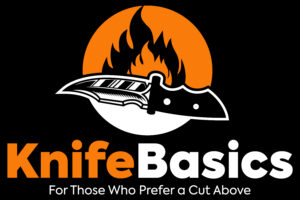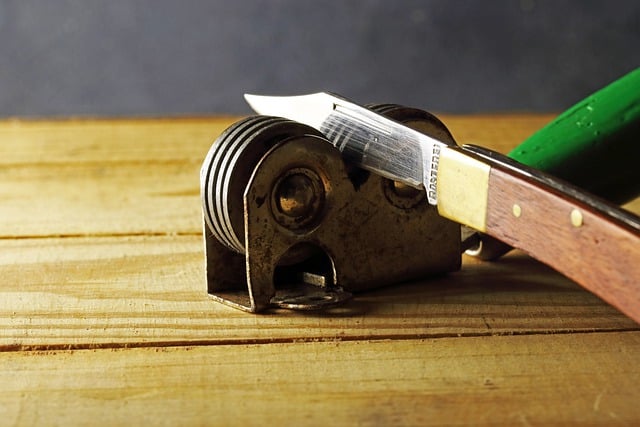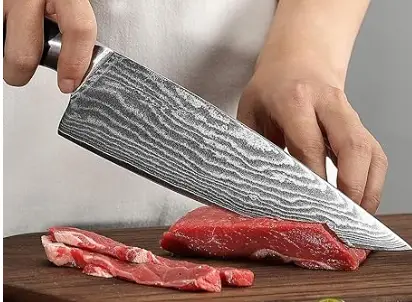Santoku and Chef’s Knife – The main differences
The main difference between a Santoku knife and a Chef knife is that a Santoku knife is from Japan and features no tip while a chef knife is from the western world and has a tip. Another key notable difference is that most Japanese Santoku knives feature single-bevel edges while Chef knives feature double-bevel edges.
The Santoku knife is a Japanese-style all-purpose kitchen knife. It is similar to a chef’s knife, but has a few key differences. The most noticeable difference is the Santoku’s blade, which is straighter and has a sheepsfoot tip.
This blade shape is designed for slicing, dicing, and mincing. The Santoku is also shorter and lighter than a chef’s knife, making it easier to control. The Santoku is a great all-purpose knife, but it excels at slicing and dicing.
The straighter blade and sheepsfoot tip make it easy to get a clean cut, and the shorter length and lighter weight make it easy to control. If you’re looking for a versatile knife that can do it all, the Santoku is a great option.
The chef’s knife is the most versatile and widely-used knife in the kitchen. It can be used for everything from chopping vegetables to slicing meat. The chef’s knife has a curved blade that is designed for rocking and chopping.
The curved blade also makes it easier to scoop up chopped food and transfer it to a pot or pan. The chef’s knife is the workhorse of the kitchen and can be used for just about anything.
The Santoku has a straighter blade with a sheepsfoot tip that is designed for slicing, dicing, and mincing. The chef’s knife is the most versatile and widely-used knife in the kitchen. It has a curved blade that is designed for rocking and chopping.
If you’re looking for an all-purpose knife, the Santoku is a great option. If you’re looking for a knife that can do it all, the chef’s knife is the way to go.

View this Wusthof Santoku Knife
What is a Santoku knife?
The name Santoku translates to “three virtues.” The three virtues referred to are slicing, chopping, and dicing.
Some people also associate the three virtues to the ability to use all the blade’s three parts: the cutting edge for slicing, the heel for chopping, and the curved tip for detailed work.
Whichever translation you adopt, the versatility of the Santoku knife makes it a must-have.
What is a Santoku knife used for?
Santoku translates to “three virtues.” Therefore, a Santoku knife can be used for three different uses:
- Chopping: Can be used to chop meat
- Slicing: Can be used to slice and dice fruits, vegetables and nuts
- Mincing: Can be used in mincing of meat and herbs
Some chefs explain the three uses in terms of, it can be used to work on meat, vegetables, and fish. Others associate In addition, the Santoku knife features a short and flat blade with a wide cutting edge and curved tip.
This allows for a quick up and down chopping without the need for rocking. This type of cutting involves lifting the knife off the chopping board between the cuts.
What steel is used to make Santoku knife?
The best Santoku knives are made of VG10 Stainless steel in a Damascus pattern. VG10 is a premium Japanese stainless steel that offers incredible hardness, edge retention, and corrosion resistance.
What is a hollow edge Santoku knife used for?
Another outstanding feature of the Santoku knife is the Granton” or “scalloped” edge. The hollowed-out indentations on the edge create air pockets between the knife and ingredients to prevent ingredients from sticking to it. This feature makes Santoku knife a perfect choice for cutting uniform fish slices for making sushi, sashimi, and mincing delicate herbs.
Japanese knives are mostly single beveled like the Usuba knife. However, Some Santoku manufacturers are known for creating it as a double bevel. This means that it can be sharpened on two sides.
Features of Santoku knife in summary
- Originated from Japan
- Broad blade with a curved tip
- Thin blade for refined slicing
- Available as both single and double bevel
- Lighter to hold
- Granton edge that prevents ingredients from sticking to it
- It varies in size from 5″ to 7.9.”
How to sharpen Santoku knife?
Santoku knives are recommended to be sharpened by a whetstone rather than sharpening steel. Sharpening steel may damage the thin Santoku knife steel. A whetstone will be much easier to use and will yield a sharper edge so long as the angle of sharpening is kept right. The best angle to sharpen a Santoku knife is recommended to be about 10 to 15 degrees.

What is a Chef knife?
Chef’s knife is a western-style knife. It is considered a must-have in the kitchen because of its many uses. It is longer and bulkier than the Santoku knife and features a double bevel blade only.
The blade of a chef knife is curved and has a tip. This allows for the rocking motion cutting style commonly known as the rock-chop. This cutting style requires you to anchor the tip of the knife on the chopping board as you rock the knife up and down.
What’s more, the different parts of the Chef’s knife are helpful. The heavy-duty heel is used to cut thick pieces of meat or dense vegetables and fruits like melons. The pointed tips come in handy for detailed cutting like trimming the fat. Lastly, the flat part of the blade helps in crushing ingredients like garlic.
What steel is used to make a Chef knife?
Most chef knives are made of stainless steel. There are lots of varieties of stainless steel and manufacturers have plenty of options to choose from. Wusthof Knife Company picks high carbon stainless steel with a hardness of 58 HRC for their chef knives. In my opinion, they offer the best craftsmanship in chef knives you can buy today. Check prices Here
Features of Chef’s knife in summary
- Originated in France and Germany
- It is a double bevel only
- A broad blade that curves to form a tip ( looks like a Gyuto knife)
- Heavier to hold
- Has a bolster
- It varies in size from 8″ to 12.”
Comparison between a Santoku and Chef knife
There are similarities and differences between Santoku and chef knives, as discussed below:
Similarities
Both Santoku and chef knives are similar in the type of cuts they offer. They can both be used to cut meat, fish, vegetable, and fruits.
Additionally, the different parts of the knife are helpful in both knives, as explained in the features section. You can use both knives for chopping, mincing, slicing, and dicing, making them very similar.
Differences
Size
In terms of size, a chef knife is longer, averaging between 8 to 12 inches, while Santoku knives are slightly smaller between 5 to 7 inches.
Blade shape
The blade of the Chef’s knife is broad and curved to form a tip, while Santoku has Hollowed-out indentations with no tip.
Blade Weight and thickness
The western chef knife has thicker and heavy blades. Also, they are generally bulky. On the other hand, Santoku blades are thinner and lightweight.
Cutting technique
The Chef’s knife requires the rock chop technique, while Santoku knives allow for the up and down chopping technique.
Which is better Santoku or chef knife?
Can a Santoku knife replace a chef’s knife?
Sources
Wusthof
https://www.wuesthof.com/en-de/



